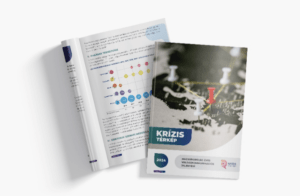Crisis Map 2024: The number of protracted crises has increased significantly
The MPRSZ registered and analyzed 450 crisis situations according to communication aspects in the Crisis Map 2024 publication. In the crisis list summarizing all crisis communication situations of the year, crisis cases in the public sector (113), the service industry (94) and the transport industry (66) dominated. The proportion of protracted cases increased and is now 42%, and the number of crisis cases that are more difficult to handle and have a direct impact on the core activities of an organization also increased.
 The crisis communication section of the Hungarian Public Relations Association prepared its crisis communication report for the sixth time. The Crisis Map, compiled by 17 experts, analyzes cases published in the press, working exclusively from external sources available to the public. The map is unique in that it presents the given year in several ways: quantitatively, through 1-1 interesting, useful, or outstanding case examples, and qualitatively, by categorizing the cases and looking for trends.
The crisis communication section of the Hungarian Public Relations Association prepared its crisis communication report for the sixth time. The Crisis Map, compiled by 17 experts, analyzes cases published in the press, working exclusively from external sources available to the public. The map is unique in that it presents the given year in several ways: quantitatively, through 1-1 interesting, useful, or outstanding case examples, and qualitatively, by categorizing the cases and looking for trends.
Among the main findings of the 2024 publication, it can be read that the time taken to resolve crisis cases has increased significantly compared to previous years, so the number of protracted cases approached 42%. The severity of the crises has also increased. 213 cases were classified as “critical” or “catastrophic”, meaning that 47% of the crises were more difficult to handle and had a direct impact on the organization’s core activities. These cases destroy and damage the reputation of the company or institution in the long term.
The authors also presented memorable cases of healthcare, transportation, technology, service, energy, public life, FMCG, capital goods, and finance through the characteristics and trends of nine industries. In addition to public life with 113 cases, the TOP3 industries generating the most crises included the service industry with 94 cases and transportation with 66 cases. These three industries account for nearly 61% of the total number of cases. The number of crises arising from workplace discrimination is increasing year by year. While only 3 such cases were reported in the Hungarian press in 2017, in 2024 the editors registered 31 such crises. Deepfake videos produced with artificial intelligence were first published last year, and perpetrators tried to deceive customers with content compiled by famous, popular, and credible experts in health issues.
In addition to industry analyses, the authors use several case studies to highlight the specifics of crisis communication. Among other things, they highlight that silence is one of the reasons for rejecting energy industry investments, but they also point out what communication steps can help, for example, in cases of internal tensions or to calm communication storms around personal brands.
Related news
We have the winners of the Employer Branding Award
🎧 Hallgasd a cikket: Lejátszás Szünet Folytatás Leállítás Nyelv: Auto…
Read more >ICCO World PR report: first in ESG and MI
🎧 Hallgasd a cikket: Lejátszás Szünet Folytatás Leállítás Nyelv: Auto…
Read more >The first PR Trend Report in Hungary has been published
🎧 Hallgasd a cikket: Lejátszás Szünet Folytatás Leállítás Nyelv: Auto…
Read more >Related news
László Pekó: “Coop isn’t just a network, it is a way of life – and has been for 30 years”
🎧 Hallgasd a cikket: Lejátszás Szünet Folytatás Leállítás Nyelv: Auto…
Read more >(HU) Karácsonyi tv-reklámok 2025 – indul a közönségdíj szavazás
🎧 Hallgasd a cikket: Lejátszás Szünet Folytatás Leállítás Nyelv: Auto…
Read more >McDonald’s restaurants will be closed nationwide on December 24-25
🎧 Hallgasd a cikket: Lejátszás Szünet Folytatás Leállítás Nyelv: Auto…
Read more >






